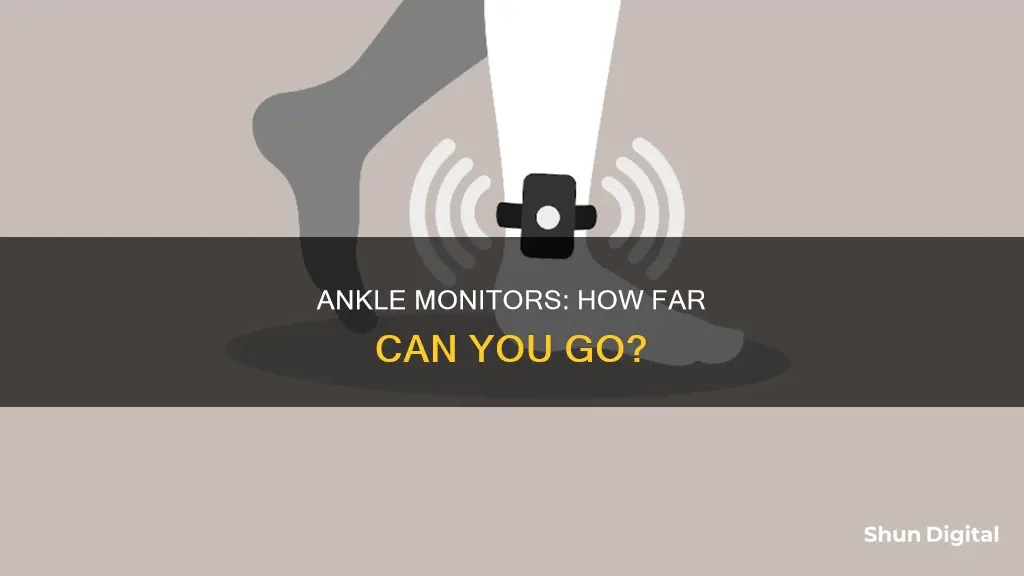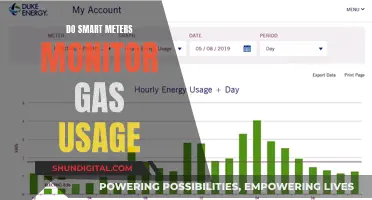
Ankle monitors are commonly used in law enforcement to track an individual's location, usually as part of a parole or home arrest condition. They are often used as an alternative to incarceration, allowing individuals to be punished without being imprisoned. The distance an individual can go with an ankle monitor depends on the case, and is decided by the presiding judge. Typically, an ankle monitor will allow movement within a 50 to 150-foot radius of a designated area, such as the wearer's home, and will notify authorities if this perimeter is breached.
| Characteristics | Values |
|---|---|
| Maximum distance | 50 to 150 feet |
| Data upload distance | Within 30 feet |
| Alert | Vibrate or beep |
| Battery life | 40 hours |
| Charging time | 2 hours |
| Charging frequency | Daily |
| Alert for low battery | Vibrate or beep |
| Alert for malfunction | Vibrate or beep |
| Alert for leaving designated area | Vibrate or beep |
| Alert for interference with signal | Vibrate or beep |
| Alert for contact from probation officer | Vibrate |
| Lights | Red, yellow, green |
| Light meaning | Red: low battery or incomplete action; Yellow: receiving power; Green: initialisation |
| Rules | Must work, meet supervisory conditions, pay court fees, meet with probation or parole officer |
What You'll Learn

Maximum distance allowed by ankle monitors
Ankle monitors are commonly used in law enforcement to track an individual's location, usually as part of a parole or home arrest condition. They are often used as an alternative to incarceration, allowing individuals to be punished without being imprisoned. The maximum distance allowed by ankle monitors varies depending on the technology used and the specific case.
Most ankle monitors use GPS or radio transmission technology to track an individual's location. The maximum distance for GPS tracking ankle monitors can range from 50 to 150 feet, with a rare few extending further. These monitors use cellular signals to triangulate the wearer's position and communicate with computers. On the other hand, radio frequency (RF) monitors do not provide an exact location but instead alert authorities when the wearer enters or exits a predetermined range.
The presiding judge typically decides the allowable distance for each case. For example, individuals under house arrest are typically restricted to a specific area, while others may be allowed to travel farther with certain caps and restrictions. Additionally, the monitor's data upload requirements may dictate how far one can go; some systems require the wearer to be within 25 to 30 feet of the home unit to upload and send data.
It is important to note that tampering with or attempting to remove an ankle monitor is a violation of parole or probation and can result in severe legal consequences.
Connecting Your TV Monitor to a Comcast Cable Box
You may want to see also

What happens if you go beyond the allowed distance
If you go beyond the allowed distance on an ankle monitor, you will be violating the terms of your release, and the consequences could be serious. The ankle monitor will send an alert to the relevant authorities, and you may face additional penalties, including jail time.
The purpose of an ankle monitor is to ensure that the wearer stays within the boundaries set by the court. These boundaries are typically established to restrict the individual's movement as a parole requirement or house arrest. In some cases, ankle monitors are used to ensure that an individual maintains a required distance from a victim or witness in a case.
If you go beyond the allowed distance, the ankle monitor will likely vibrate and emit a loud tone to notify you that you are about to violate the terms of your release. If you do not return to the designated area, the device will send an alert to the authorities, who may take action to apprehend you and bring you back into custody.
It is important to note that the consequences of violating the terms of your release can vary depending on the specific circumstances of your case and the jurisdiction. However, in general, violating the terms of your release by going beyond the allowed distance on your ankle monitor is considered a serious offense and can result in significant legal consequences.
To avoid violating the terms of your release, it is important to understand the restrictions that have been placed on your movement and to stay within the designated areas. If you need to travel outside of the allowed areas, you may be able to schedule the activity in advance with the relevant authorities, or in the case of an emergency, contact them for permission to leave the designated area.
Monitoring Android CPU Usage: A Comprehensive Guide
You may want to see also

How to get permission to travel to more locations
The distance an individual can travel while wearing an ankle monitor is determined by a number of factors, including the technology used and the specifics of their case. The maximum distance is typically between 50 and 150 feet, but some systems may require the wearer to stay within 25 to 30 feet of the home unit for data uploads. Ultimately, the allowable distance is decided by a judge based on the needs of the wearer and the reason for the monitor.
If you need to travel to more locations than your ankle monitor allows, there are a few steps you can take to request permission:
- Contact your probation or parole officer: Explain your situation and reasons for needing to travel to additional locations. They may be able to grant you permission or advise you on the next steps.
- Obtain written permission: If your request is approved, make sure to get written permission from your probation or parole officer. This document should clearly state your travel dates, destinations, and any other relevant details. Keep this document with you at all times during your trip.
- Notify relevant authorities: In addition to your probation or parole officer, you may need to inform the court or the company that attached the monitor. They will need to know about your travel plans in advance so they can monitor your movements.
- Schedule your travel in advance: Ankle monitors with location tracking typically require that travel outside of your permitted area is scheduled ahead of time. This allows the authorities to know when and where you will be travelling.
- Be prepared for additional security checks: If you are travelling by air, expect additional security screening at the airport. Inform the Transportation Security Administration (TSA) agents about your ankle monitor ahead of time and be prepared to show any necessary documents.
- Consider alternative travel options: If flying is not feasible, consider other options such as driving, bus, or train. These methods may be easier to navigate with an ankle monitor and can give you more control over your trip.
Unlocking Your Monitor's Potential: Uncapping FPS on ASUS Displays
You may want to see also

What happens if you need to leave the designated area in an emergency
If you need to leave the designated area in an emergency, you must contact the relevant authorities to get permission. The ankle monitor will notify the officers in charge of your case if you travel outside the permitted area.
The exact steps you need to take will depend on the specifics of your case, including the type of ankle monitor you are wearing and the terms of your release. For example, if you are wearing a Radio Frequency (RF) ankle monitor, you may need to be within a certain range of the receiver to send the required data.
It is important to note that violating the terms of your release by leaving the designated area without permission could result in additional penalties, including jail time.
Monitoring iPad Usage: Strategies for Parents and Guardians
You may want to see also

How to remove an ankle monitor
Ankle monitors are used by law enforcement to keep track of an individual's whereabouts. They are usually worn by people who are under house arrest or probation. The monitors use GPS technology or radio transmission to transmit data to an electronic monitoring program.
- Talk to your probation officer: Discuss your intention to remove the ankle monitor with your probation officer. They will help you schedule a meeting with the judge.
- Prepare a strong argument: You will need to present a valid argument and a strong motive for removing the monitor. The judge will decide whether or not to approve your request.
- Write a motion: Draft a legal document, or motion, explaining your case to the judge. Include a brief introduction, background information about your offence and probation conditions, and a clear explanation of why you want the monitor removed.
- File the motion: Submit the motion to the court and attend the hearing. Bring all relevant legal documents and arrive on time. The judge will make the final decision.
It is important to note that attempting to remove an ankle monitor without following legal procedures can have serious consequences. Some monitors have sensors that will alert authorities if tampered with. Therefore, it is crucial to follow the proper steps and obtain legal approval before attempting to remove the device.
Blind Spot Monitoring: Is It Available on the Nissan Kicks?
You may want to see also







